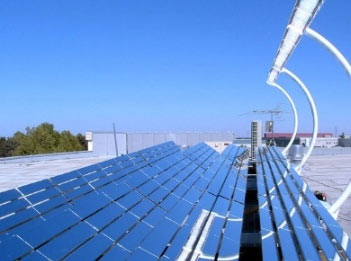Technologies collectively known as concentrating photovoltaics are starting to enjoy their day in the sun, thanks to advances in solar cells, which absorb light and convert it into electricity, and the mirror- or lens-based concentrator systems that focus light on them. The technology could soon make solar power as cheap as electricity from the grid.
The idea of concentrating sunlight to reduce the size of solar cells—and therefore to cut costs—has been around for decades. But interest in the technology has picked up in the past year. Last month, Japanese electronics giant Sharp Corporation showed off its new system for focusing sunlight with a fresnel lens (like the one used in lighthouses) onto superefficient solar cells, which are about twice as efficient as conventional silicon cells reports Kevin Bullis.
. Other companies, such as SolFocus, based in Palo Alto, CA, and Energy Innovations, based in Pasadena, CA, are rolling out new concentrators. And the company that supplied the long-lived photovoltaic cells for the Mars rovers, Boeing subsidiary Spectrolab, based in Sylmar, CA, is supplying more than a million cells for concentrator projects, including one in Australia that will generate enough power for 3,500 homes.
The thinking behind concentrated solar power is simple. Because energy from the sun, although abundant, is diffuse, generating one gigawatt of power (the size of a typical utility-scale plant) using traditional photovoltaics requires a four-square-mile area of silicon, says Jerry Olson, a research scientist at the National Renewable Energy Laboratory, in Golden, CO. A concentrator system, he says, would replace most of the silicon with plastic or glass lenses or metal reflectors, requiring only as much semiconductor material as it would take to cover an area the size of a typical backyard. And because decreasing the amount of semiconductor needed makes it affordable to use much more efficient types of solar cells, the total footprint of the plant, including the reflectors or lenses, would be only two to two-and-a-half square miles. (This approach is distinct from concentrated thermal solar power, which concentrates the heat from the sun to power turbines or sterling engines.)
"I’d much rather make a few square miles of plastic lenses—it would cost me less—than a few square miles of silicon solar cells," Olson says. Today solar power is still more expensive than electricity from the grid, but concentrator technology has the potential to change this.
Indeed, if manufacturers can meet the challenges of ramping up production and selling, distributing, and installing the systems, their prices could easily meet prices for electricity from the grid, says solar-industry analyst Michael Rogol, managing director of Photon Consulting, in Aachen, Germany.
But the approach has been difficult to implement. "It has not delivered on the promise, mostly because of the complexity of the systems," Rogol says. The goal is to engineer a concentrating system that focuses sunlight, that tracks the movement of the sun to keep the light on the small solar cell, and that can accommodate the high heat caused by concentrating the sun’s power by 500 to700 times—and to make such a system easy to manufacture.
In the face of this complexity, many have decided to focus their research efforts on cutting the cost of traditional "flat-plate" systems. This is done through making them thinner, to decrease the amount of semiconductor needed, or through turning to cheaper, though less efficient, organic materials. But now several companies claim to have developed reliable systems that can be manufactured on a large scale. For example, SolFocus is making a system that combines the concentrators and cells in one sealed package by employing manufacturing techniques similar to those used to make automobile headlamps. This way they can easily be created in large quantities, according to the company’s CEO, Gary Conley.
As for the use of superefficient solar cells, critics originally said that although the cells worked well in the lab, it would be unlikely that their high efficiencies could be maintained in large-scale manufacturing. Unlike conventional solar cells, which use only one type of semiconductor (silicon), these more efficient cells, called multijunction cells, are made from layers of three types of semiconductor. This approach is meant to overcome a major limitation of silicon: although it can absorb photons from most of the spectrum in sunlight, it does so inefficiently, converting into heat, rather than into electricity, most of the energy in high-energy photons from the blue and ultraviolet parts of the spectrum. The multijunction cells use three materials designed to efficiently convert light from different parts of the spectrum, the result being that much less is converted into heat and much more into electricity.
All of the materials must be carefully engineered to work with the other materials, and they have to be assembled under very clean, well-controlled conditions. So in the 1990s, when this type of cell was still experimental, people called it "a laboratory curiosity that could never be manufactured in large volume," Olson says. "Now Spectrolab on their production floor does better than we do in the lab. So it basically blew that myth out of the water."
Other factors that have limited the use of concentrated solar, such as aesthetic objections to mounting concentrator systems on suburban rooftops, may largely restrict applications to commercial buildings or arrays in the desert.
But the advances that have come about, along with growing demand for solar and a shortage of silicon feedstock, have made concentrated solar photovoltaics attractive.
"There’s a lot of uncertainty in this area, where historically there’s been a lot of hype that just hasn’t been delivered," Rogol says. "The biggest news for me is that serious solar people, over the course of the last year, have made notable commitments to concentrators."

